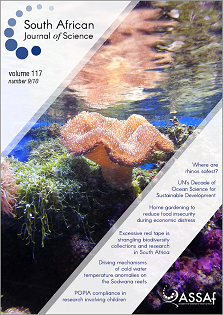Excessive red tape is strangling biodiversity research in South Africa
DOI:
https://doi.org/10.17159/sajs.2021/10787Keywords:
research productivity, human capital development, Nagoya Protocol, bureaucracyPublished
2021-09-29
Issue
Section
Commentary
License

This work is licensed under a Creative Commons Attribution 4.0 International License.

All articles are published under a Creative Commons Attribution 4.0 International Licence
Copyright is retained by the authors. Readers are welcome to reproduce, share and adapt the content without permission provided the source is attributed.
Disclaimer: The publisher and editors accept no responsibility for statements made by the authors
How to Cite
Alexander, G. J., Tolley, K. A., Maritz, B., McKechnie, A., Manger, P., Thomson, R. L. ., Schradin, C., Fuller, A., Meyer, L., Hetem, R. S. ., Cherry, M., Conradie, W., Bauer, A. M., Maphisa, D., O'Riain, J., Parker, D. M. ., Mlambo, M. C. ., Bronner, G., Madikiza, K., … Kerley, G. I. (2021). Excessive red tape is strangling biodiversity research in South Africa. South African Journal of Science, 117(9/10). https://doi.org/10.17159/sajs.2021/10787
Views
- Abstract 4245
- PDF 1401
- EPUB 210
- XML 209










.png)